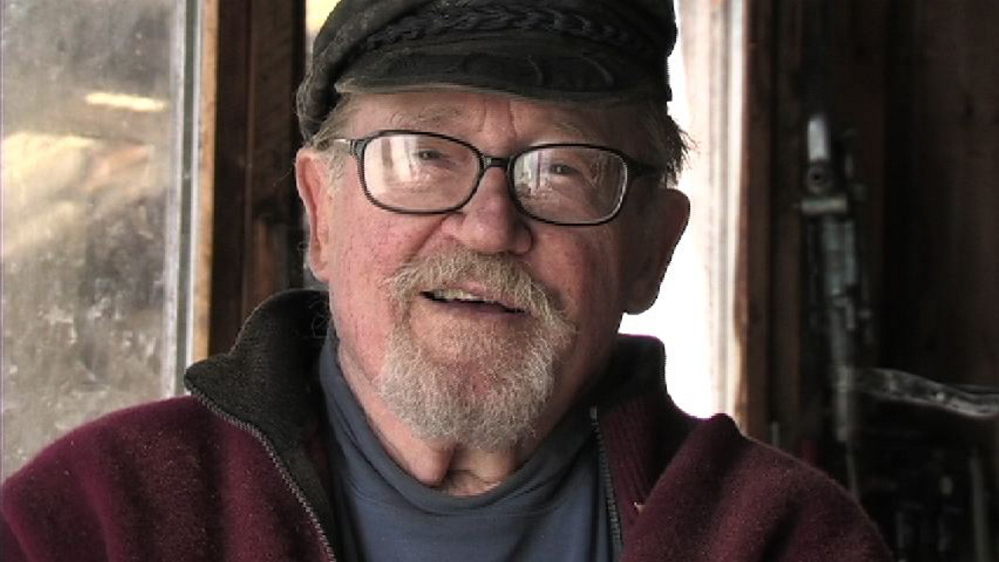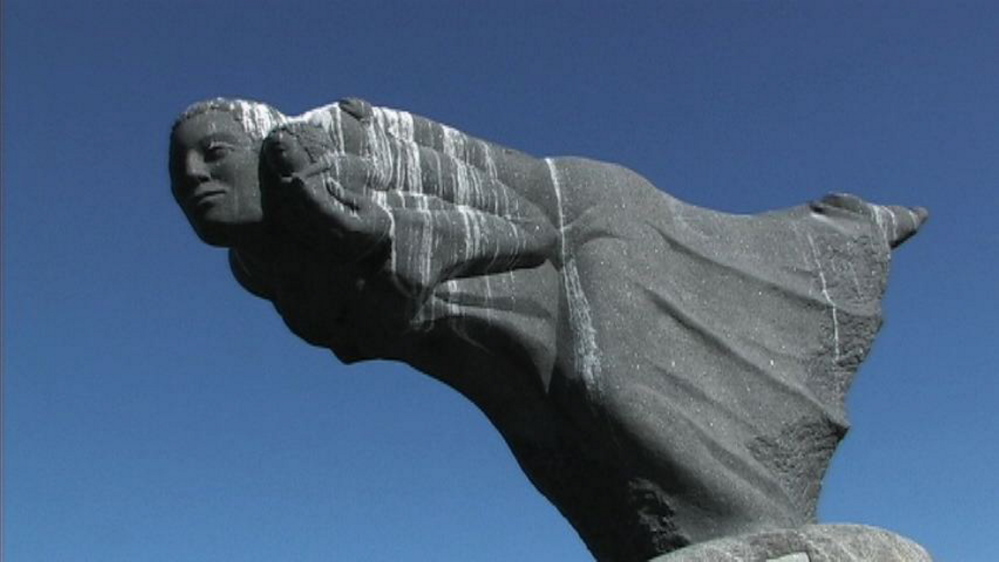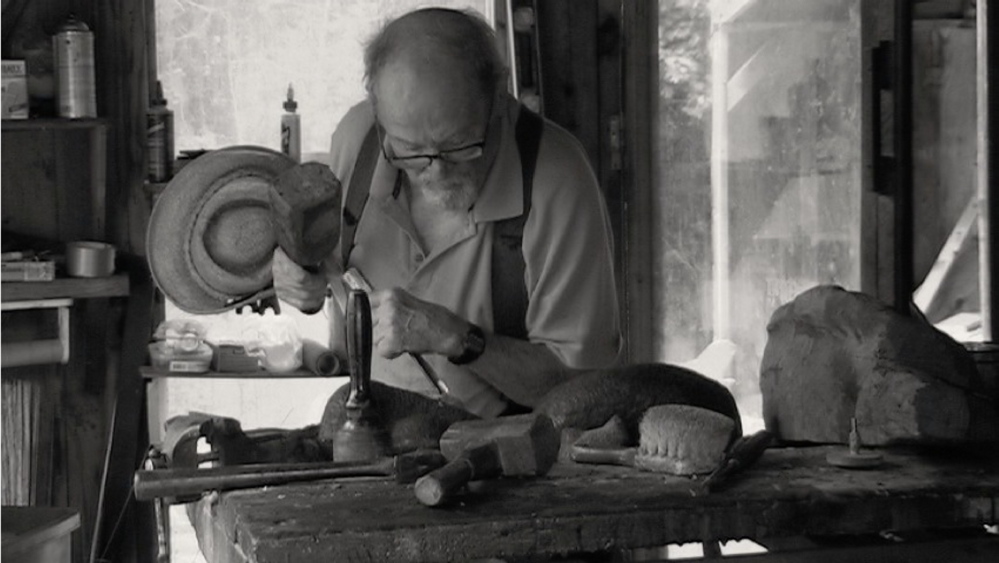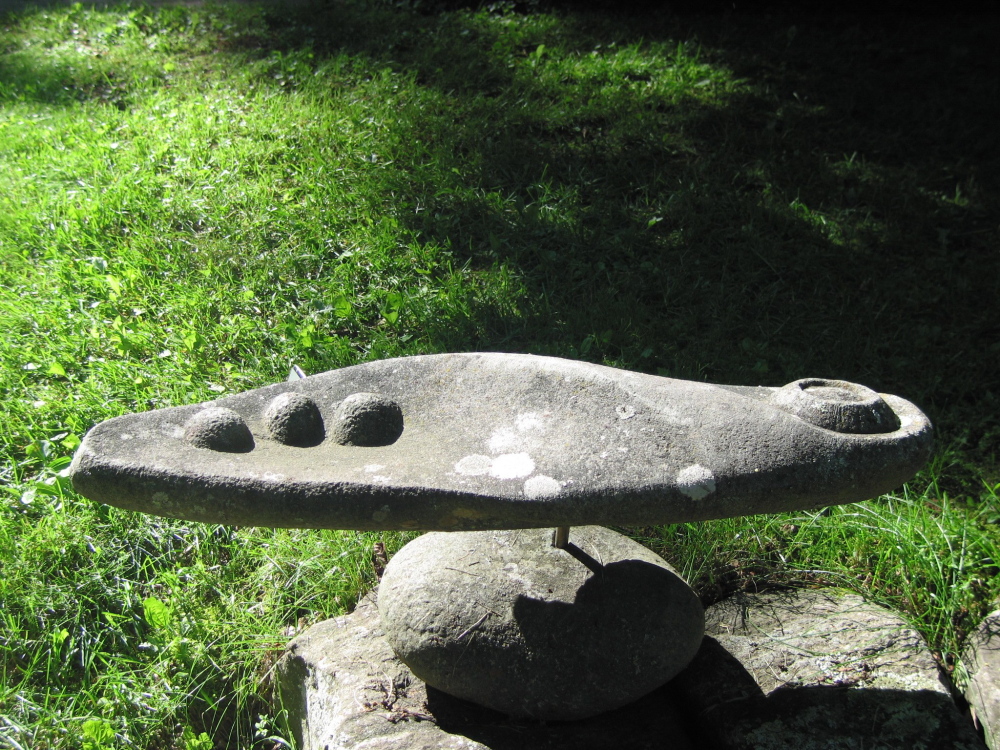Dale Schierholt’s “Cabot Lyford: Portrait of a Man as Artist” is a strong addition to the Maine Masters project, an ongoing series of film portraits of distinguished Maine artists.
While Lyford has exhibited widely over decades, he is probably best known in Maine for his carved stone sculpture “Dolphins” in front of the Regency Hotel in Portland. After viewing Schierholt’s film, I saw the sculpture differently: I could feel the mass of the dolphins emerging from the similarly-weighted water. The sculpture became as much about the stone and what it revealed when carved, and the dolphins a compelling metaphor for the mystery and emergence of carved sculpture.
“Portrait” is a half-hour film that takes a quiet and simple approach, relying mostly on shots of Cabot Lyford, now in his late 80s, working on sculpture in his New Harbor studio. The only voice is Lyford’s and his narrative commentary moves easily between story, observations about his work and a few technical explanations that throw a great deal of light back onto the physical effort of making sculpture.
Switching to a wood mallet from a heavier metal one to drive his chisels through wood, for example, is Lyford’s story of aging. But when he raises a hand to show the effects of arthritis, it’s hard to see past his powerful arm. He momentarily jokes about complaining, but his comments about his knee and shoulder replacements are hardly intended to foment pity. Lyford’s physical relationship to the wood and stone, after all, is what drives and forms his sculpture. It always has.
“Portrait” is not only an appealing film about a talented and affable Maine artist; it is an extraordinary document of the American moment in art.
Lyford begins his story in a WWII foxhole in the Pacific where he found a specific and, ultimately, life-long “desire to do something worthwhile with the years I had been spared.” Within a week of returning home from war, Lyford was back at college. One of the great engines of the ascendancy of American art was the G.I. Bill, and soon Lyford was part of this first wave – a bona fide tsunami – of veterans flooding art schools.
His first serious art experience, however, was in 1947 at the Skowhegan School of Painting & Sculpture, which had only opened the year before. It was there that Lyford made his first sculpture. And it was then the young man who had gone to Harvard on a football scholarship decided to switch to Cornell to study fine art.
Lyford’s story is the story of Abstract Expression and the American Studio Craft Movement. In fact, his comments, philosophy, history and work could hardly comprise more succinct syncretism of the two.
Lyford recalls the solidity of his atheism in that Pacific foxhole and how the “desire for something more got me into art.” It led to what he calls an “arrogant approach” of wanting “to do something significant.” But it is in fact a very humble story. When Lyford encountered the iconic Greek marble “Nike of Samothrace” at the Louvre, it literally brought him to his knees. And it gave him faith in the culture of art as an engine for lasting meaning.
POST-WAR PERSPECTIVE
While we watch video of Lyford chipping away at a block of wood or cutting a log with a chainsaw, his voice-over calmly discusses his drive to articulate his own vision through sculpture. Lyford’s aphorisms are not pithy sound bytes. They make sense. They feel honest. They do far more than reveal Lyford’s personal aspirations. They teach us about post-war American art from the perspective of the artist.
Lyford starts his sculpture with a stone or log. He lets this block determine his subject. Sometimes, they reveal themselves clearly to him: “Stone has forms that need to be released.” And other times, particularly with wood, it takes more work to find the subject: “Wood is more reluctant to give up its meaning than stone.”
Lyford’s sculptures take organic forms. His nudes are abundant and curvy when he carves them from stone. Just as often, Lyford’s sculptures become faces, animals, figures or non-representational forms he describes as “just shapes.”
Lyford’s stone works – made outside throughout the year – blend raw stone with rough-hewn and high-polish parts. His works in wood are driven by thick and deep chisel marks that feel like Abstract Expressionist-inspired brush strokes. Instead of making “absolute replicas of the objects (he is) borrowing from,” Lyford wants his sculptures to be loose enough to echo their original stone or log.
UPWARD AND FORWARD
Schierholt shows Lyford visiting his monumental “My Mother the Wind,” which was permanently installed on Four Tree Island in Portsmouth in 1975. It is a triangular form that reverses the idea of “The Avenger,” the warlike masterwork of German Expressionist sculptor Ernst Barlach. Instead of the “crystallized essence of War” – Barlach’s words – in the triangular form of a man with a sword, Lyford gives us a mother with child in the triangular form of a ship’s figurehead moving upward and forward into the adventurous future.
The presence of his great work is a philosophical place for the sculptor who candidly explains: “The last year or so, it’s become much more difficult than it used to be; physically, it’s so painful that I have to be very dilatory in pursuing it.” But pursue the work he does, because it’s his life.
“If I don’t carve, I might as well be dead,” he says. This is not a dramatic comment; it’s a realistic one from a seasoned man who understands his own wellspring of meaning.
Since that existential moment in the foxhole, Lyford has been an artist in pursuit of life and legacy. He muses about “Mother,” on permanent display in Portsmouth: “I want something that lasts forever – beautiful, meaningful and lasts forever.” Standing before such a work, it’s a thought that makes him smile.
Freelance writer and critic Daniel Kany is an art historian who lives in Cumberland. Contact him at
dankany@gmail.com
Copy the Story LinkSend questions/comments to the editors.






Success. Please wait for the page to reload. If the page does not reload within 5 seconds, please refresh the page.
Enter your email and password to access comments.
Hi, to comment on stories you must . This profile is in addition to your subscription and website login.
Already have a commenting profile? .
Invalid username/password.
Please check your email to confirm and complete your registration.
Only subscribers are eligible to post comments. Please subscribe or login first for digital access. Here’s why.
Use the form below to reset your password. When you've submitted your account email, we will send an email with a reset code.